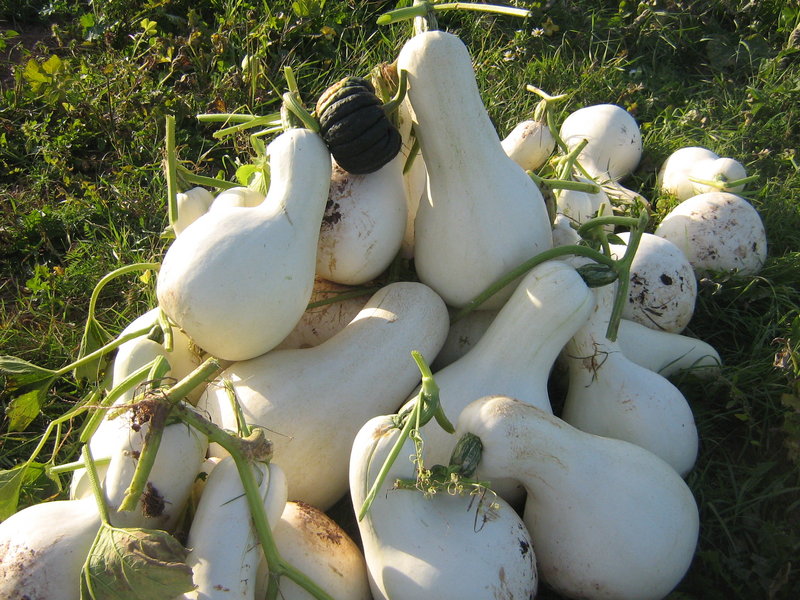Back to January 2015 Newsletter
The Gila Monsters of Skye Glen

“Do what you can with them – they look pretty dead.”
Angie Koch, the Seeds of Diversity’s Seed Library Co-ordinator, was not optimistic about the C. mixta squash seeds she was giving me. Our group of Cape Breton farmers had volunteered to help with renewing the Seed Library's collection of cucurbits, and I wasn't too optimistic about these particular seeds either.
Apart from the fact that Cape Breton is not known for the long, hot, dry summers most mixtas are used to, the twenty seeds of Gila Cliff-dweller squash she sent me – all that existed in the collection – were dry and cracking, some even split outright. We’d agreed that I could supplement with some purchased seed, but I could only find two small companies who sometimes offered Gila Cliff-dweller, and they weren't answering my calls.
“Right, guys” I told the decrepit seeds. “You're it.”
These squashes were originally grown by the First People who lived around the Gila (pronounced “hee-la”) National Monument in New Mexico, famous for its cliff caves that provided shelter from weather and hostile neighbouring tribes.
|
Last year we had a host of gardeners who volunteered to grow out squash, cucumber and melon varieties for our Canadian Seed Library, and we’ve been excitedly receiving packets of fresh seed in the mail from our growers over the past couple of months. This year, we'd like to identify experienced volunteers to grow out biennial vegetable seeds. Read more here or contact angie@seeds.ca if interested. |
Cape Breton, sticking out into the North Atlantic, is a long way from New Mexico. I needed to give these seeds the best head start I could. We can't set out squashes here until early July, and we can get frost by early September, so in late May I planted each seed carefully into its own 2” soil block and placed them on a heat mat. I hovered over them every day, misting the blocks so they didn't dry out. I was floored when 14 of the 20 actually sprouted. They seemed to want to justify my fragile faith in them. They quickly outgrew the 2 inch blocks so I bumped up the compost level and potted them on into the rarely used 4” blocks. By late June they were huge, with large speckled leaves growing up against the glass – a little longer and they would have been demanding free speech and the right to self-determination.
This is where the seeds and I got lucky. This summer was the hottest and driest we have had in over ten years. There was little rain in May and June and none in July. I have great soil structure with high organic matter levels, and I do not irrigate. The carrots pouted, a few tomato varieties got blossom end rot, and the potatoes engaged in a full-on strike.
But the Gila Cliff-dwellers felt right at home. I’d given each a generous 10' x 10' space, but by end of July they had filled that completely. By mid-August they were encroaching on the onions to the south and tomatoes to the north. I was starting to call them Gila Monsters. In the middle of the day, the sound of bees working the cucurbit section was deafening. Bees of all kinds flew in and out of the myriad blossoms in a kind of intoxicated, ecstatic state – I could only go into the patch safely before 6 am.
The fruits themselves were getting to be an impressive size. I anxiously headed to the Internet to see what I had gotten myself into. Turns out these squashes commonly reach 20-30 lbs. I would have to give some serious thought to post-harvest handling! I began ruthlessly pruning and picking off the smaller fruits in the hope that the larger ones’ seeds would ripen enough before frost. I ate quite a few, which were a nice enough summer-squash, but gave up after awhile and fed them to my sheep. I picked and stuffed blossoms. Gave that up and fed them to the chickens. No frost in September or early October, which I was still trying to feel was good luck.
Finally, on Thanksgiving weekend, the monster squashes had that good hollow sound when thumped and a nice hard rind. I harvested 29 of them – which totaled over 600 lb – and piled them in a corner of my living room. None were less than 15 lbs, and the largest, which I had taken to calling “Butch” and talking to as if it were a person, weighed 33 lbs. I “loaned” a few out to gullible friends who could be counted on to return the seeds to me. As one said, “They're alright but they need work. Mostly in the form of butter.” A friend who owns Big Spruce craft brewery offered to make Gila Squash Ale and took ten. I made any recipe I could find, but the mountain in my living room still loomed by the end of November.
The rest, I am afraid, went to the cow and sheep, who - though appreciative – were oblivious to the rare nature of their dessert. We've gone from 20 dubious seeds of a rare and fascinating squash to a gracious plenty for all of Canada in a single season. A good toast for the year indeed!
~Michelle Smith, member & volunteer from Skye Glen, Cape Breton
Not yet a member?
An annual membership to Seeds of Diversity gives you access to our seed exchange, seed grow-out programs, and our online news.

We depend on donations to do our work.

Thank you for your support!
